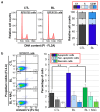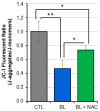Blue Light-Induced Mitochondrial Oxidative Damage Underlay Retinal Pigment Epithelial Cell Apoptosis
- PMID: 39684332
- PMCID: PMC11641757
- DOI: 10.3390/ijms252312619
Blue Light-Induced Mitochondrial Oxidative Damage Underlay Retinal Pigment Epithelial Cell Apoptosis
Abstract
Reactive oxygen species (ROS) play a pivotal role in apoptosis. We reported that Blue Light (BL) induced oxidative stress in human retinal pigment epithelial (RPE) cells in vitro and increased drusen deposition and RPE cell apoptosis in human eyes. Here, we investigated the mechanisms underlying BL-induced damage to RPE cells. Cells were exposed to BL with or without the antioxidant N-acetylcysteine. Cells were analyzed for levels of ROS, proliferation, viability, and mitochondria membrane potential (ΔΨM) fluctuation. We performed proteomic analyses to search for differentially expressed proteins. ROS levels increased following RPE cell exposure to BL. While ROS production did not affect RPE cell proliferation, it was accompanied by decreased ΔΨM and increased cell apoptosis due to the caspase cascade activation in a ROS-dependent manner. Proteomic analyses revealed that BL decreased the levels of ROS detoxifying enzymes in exposed cells. We conclude that BL-induced oxidative stress is cytotoxic to RPE cells. These findings bring new insights into the involvement of BL on RPE cell damage and its role in the progression of age-related macular degeneration. The use of antioxidants is an avenue to block or delay BL-mediated RPE cell apoptosis to counteract the disease progression.
Keywords: antioxidant; apoptosis; blue light; caspases activation; mitochondria damage; oxidative stress; retinal pigment epithelial cells.
Conflict of interest statement
The authors declare no conflicts of interest.
Figures







Similar articles
-
Filtering blue light mitigates the deleterious effects induced by the oxidative stress in human retinal pigment epithelial cells.Exp Eye Res. 2022 Apr;217:108978. doi: 10.1016/j.exer.2022.108978. Epub 2022 Feb 5. Exp Eye Res. 2022. PMID: 35134392
-
Nuclear Factor (Erythroid-Derived)-Related Factor 2-Associated Retinal Pigment Epithelial Cell Protection under Blue Light-Induced Oxidative Stress.Oxid Med Cell Longev. 2016;2016:8694641. doi: 10.1155/2016/8694641. Epub 2016 Sep 27. Oxid Med Cell Longev. 2016. PMID: 27774118 Free PMC article.
-
Expression of endoplasmic reticulum stress markers GRP78 and CHOP induced by oxidative stress in blue light-mediated damage of A2E-containing retinal pigment epithelium cells.Ophthalmic Res. 2014;52(4):224-33. doi: 10.1159/000363387. Epub 2014 Nov 12. Ophthalmic Res. 2014. PMID: 25402962
-
Photoprotective Effects of Phytochemicals on Blue Light-Induced Retinal Damage: Current Evidence and Future Perspectives.Nutrients. 2025 Jan 17;17(2):331. doi: 10.3390/nu17020331. Nutrients. 2025. PMID: 39861461 Free PMC article. Review.
-
Retinal Pigment Epithelium Under Oxidative Stress: Chaperoning Autophagy and Beyond.Int J Mol Sci. 2025 Jan 30;26(3):1193. doi: 10.3390/ijms26031193. Int J Mol Sci. 2025. PMID: 39940964 Free PMC article. Review.
Cited by
-
Phenotypic Drug Discovery Platform by Quantitative High-Throughput Screening Identifies Antiapoptotic Molecules in a Zebrafish Model of Age-Related Macular Degeneration.ACS Omega. 2025 Jul 7;10(28):30467-30488. doi: 10.1021/acsomega.5c02227. eCollection 2025 Jul 22. ACS Omega. 2025. PMID: 40727801 Free PMC article.
-
Light Exposure as a Tool to Enhance the Regenerative Potential of Adipose-Derived Mesenchymal Stem/Stromal Cells.Cells. 2025 Jul 24;14(15):1143. doi: 10.3390/cells14151143. Cells. 2025. PMID: 40801576 Free PMC article.
References
-
- Wong W.L., Su X., Li X., Cheung C.M., Klein R., Cheng C.Y., Wong T.Y. Global prevalence of age-related macular degeneration and disease burden projection for 2020 and 2040: A systematic review and meta-analysis. Lancet Glob. Health. 2014;2:e106–e116. doi: 10.1016/S2214-109X(13)70145-1. - DOI - PubMed
MeSH terms
Substances
Grants and funding
LinkOut - more resources
Full Text Sources

